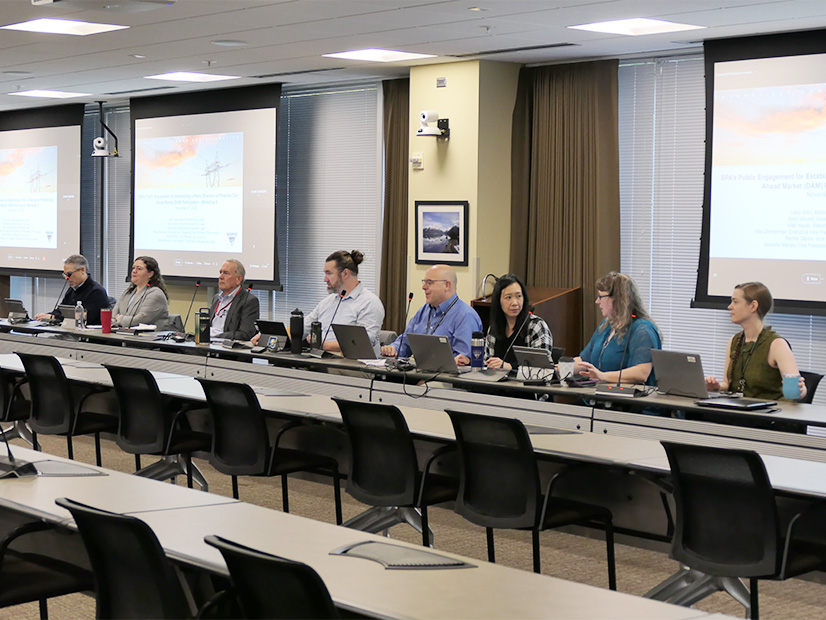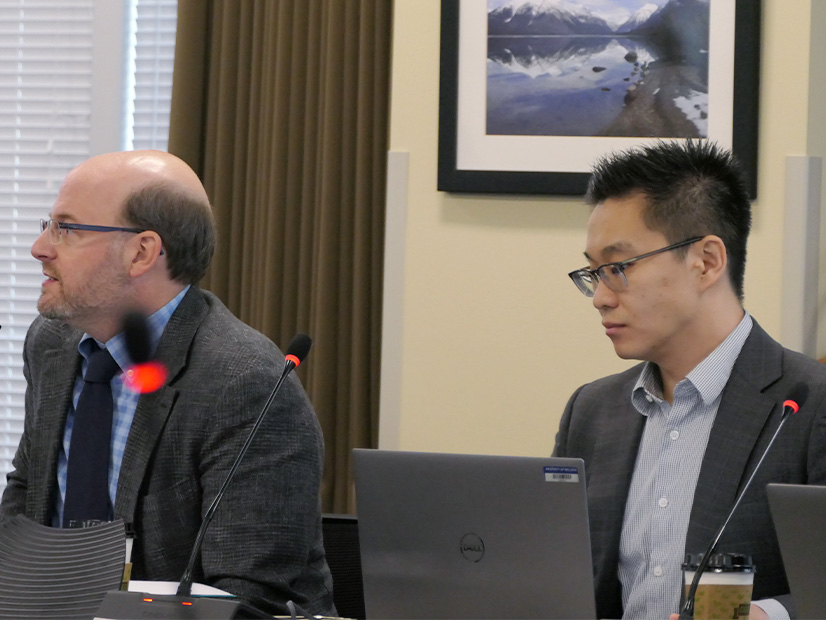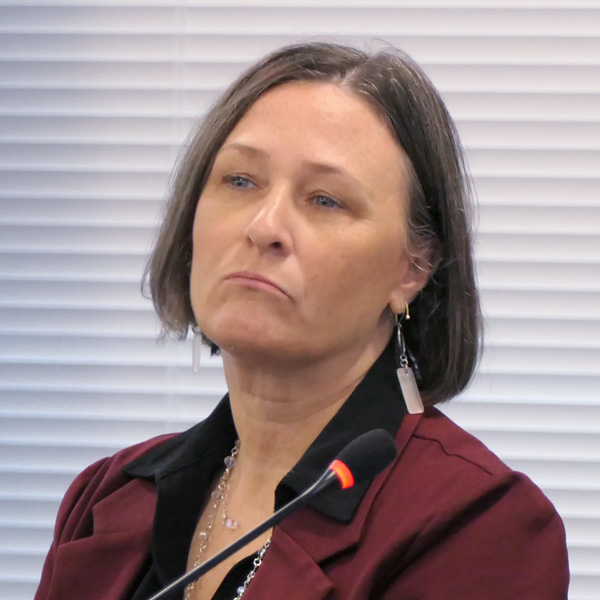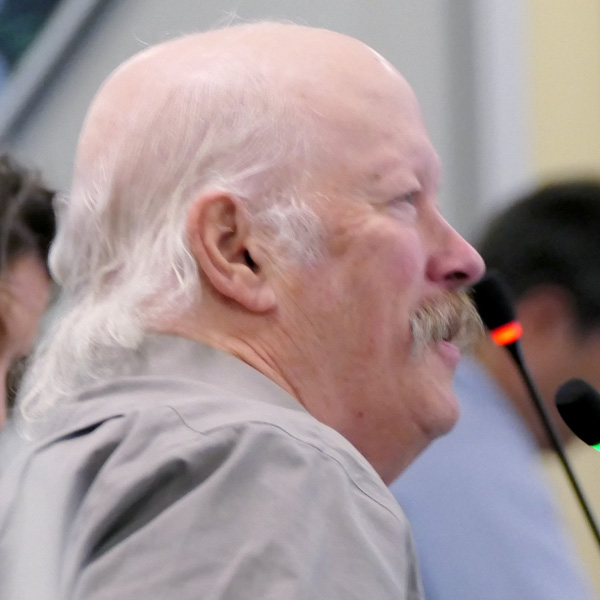
PORTLAND, Ore. — A largely polite discussion at the Bonneville Power Administration’s Nov. 4 day-ahead market participation workshop ended on a testy note as critics of a BPA staff recommendation that the agency join SPP’s Markets+ urged staff to rethink their position and consider once again delaying a decision beyond May 2025.
The workshop was the first BPA has held since announcing in August that it would postpone its final decision — originally scheduled for this month — into next year, with a draft decision targeted for March.
It was also the first such meeting since the executive leading the day-ahead markets effort, former Director of Market Initiatives Russ Mantifel, resigned on short notice in October. (See BPA Markets+ Support Intact Despite Exec’s Resignation, Agency Says.)
The discussion covered BPA’s intention to spend $25 million to fund Phase 2 of Markets+, the agency’s thoughts on the West-Wide Governance Pathways Initiative’s “Step 2” proposal and its reasons for delaying its decision.
But the key focus of the workshop was the recently released results of a production cost model study that Energy and Environmental Economics (E3) performed for BPA to estimate the comparative benefits of joining either Markets+ or CAISO’s Extended Day-Ahead Market (EDAM) under various market footprint scenarios and tested under different sensitivities, such as conditions of low hydro or stressed load.
The study, which supplements the Western Markets Exploratory Group (WMEG) study that E3 produced for BPA last year, found the agency would gain significantly more financial benefits from participating in EDAM rather than Markets+, with the largest projected take in a single, West-wide market: $251 million in savings in 2026 — compared with a “Business as Usual” (BAU) case — declining to $147 million in 2035.
But in an Oct. 31 press release announcing the study results, BPA made clear the findings would not shift its leaning in favor of the SPP market, although they would still factor into its final decision. (See BPA Sticks to Markets+ Leaning Despite Study Showing EDAM Benefits.)
BPA officials reemphasized that view during the Nov. 4 workshop, at which two of the study’s authors, E3’s Jack Moore and Yuchi Sun, detailed the study’s structure, methodology and results.
Moore reiterated a point that E3’s Arne Olson made a year ago with the release of BPA’s original WMEG study: that the supplemental study, with its focus on production costs, was not designed to capture potential savings from lower capacity needs based on resource and load diversity, the ability to procure resources over a wider geographic area and coordinated regional transmission planning.
“It is useful to note that those investment savings [and] investment impacts can be significant and sometimes larger even than production cost impact in the long run,” Moore said.
EDAM supporters in the Northwest — and elsewhere — have repeatedly argued that point when urging BPA to join a single Western market based on EDAM rather than on Markets+, the latter of which will inevitably split the region into two markets given the unlikelihood that California utilities would choose the SPP-run market and the number of utilities already lining up for CAISO’s platform.
But BPA officials at the workshop pointed to the importance of other factors not captured in the E3 study, some of which are qualitative and difficult to measure in dollars, such as the benefit of participating in a market with independent governance from the get-go.
Others are more quantitative, but still difficult to estimate in a study, such as the absence of scarcity pricing in the EDAM, market power mitigation practices, the impact of energy bid caps and the potential for CAISO — as both market operator and balancing authority participating in its own market — to “bias” operations in its own favor during stress events.
Sara Eaton, a BPA senior policy specialist, said the agency even questioned whether the supplemental study accurately reflects the financial impact from stressed grid events.
“We don’t see the pricing levels for scarcity events near the impact that we see them in in today’s world,” Eaton said. “That’s an impact that we’re not seeing reflected in the studies. Our exposure to those sorts of pricing levels don’t get incorporated into the cost” represented in the study.
Quantitative vs. Qualitative
Representatives of the large number of Northwestern publicly owned utilities that have advocated for BPA to join Markets+ backed the agency’s approach of giving the supplemental study limited weighting in its decision.
“How certain are we that the analysis actually accurately represents what would happen?” Nicolas Garcia, policy director with the Washington Public Utility Districts Association (WPUDA), asked, noting the wide range of benefit estimates included in the study. “I do think we need to take [the findings] with a little bit of a grain of salt, and I would recommend perhaps using a few more zeros and a little less ones and fives, just because I think that even though that may be what the analysis came up with, the fact of the matter is that these things are a little bit uncertain.”
Michael Linn, director of market analytics at the Portland-based Public Power Council (PPC), said his group supported “broadening the conversation beyond the production cost studies.”
Linn said the E3 study is “clearly very valuable” and that E3’s work “shows directional benefits” of BPA’s participation in a day-ahead market. “But we also see that there’s considerable variability across those modeled outcomes.”
Both Linn and Garcia emphasized the importance of market factors that are “harder to quantify.”
Linn also reemphasized Eaton’s point about the unquantified cost of resource scarcity events.
“Every year there’s some sort of issue that is a $100 [million] to $200 million issue for everybody [and] involves reliability, and the market framework where Bonneville has an equitable say in the resolution of those policy choices needs to be highly prioritized, from PPC’s perspective,” Linn said.
Garcia said the issue of governance should carry greater weight than a study showing EDAM would provide more economic benefits for BPA.
“I will say that my members, which represent about 20% of Washington’s load, very much want independent governance, even if it doesn’t come up with anything different in terms of value. We like democracy. We like independence,” he said.
Rachel Dibble, BPA vice president of bulk power marketing, said governance determines market design, which in turn determines who gains and loses under stressed grid conditions.
“When you have a governance model that has a particular responsibility to one market participant, that’s reflected in the market design, and it’s reflected in the way that benefits and costs are allocated,” Dibble said, pointing to CAISO’s policy of curtailing wheel-throughs of “low-priority” energy transfers through its balancing area during emergency conditions, which sparked the ire of Arizona utilities during stressed grid events in the summer of 2020.
Sidney Villanueva, an attorney representing Avangrid Renewables, asked for more specificity on how governance affects market design.
Dibble explained how all Markets+ participants have voting rights and are responsible for designing the market and writing its protocols, which “really encourages collaboration.”
“So, we have differently situated entities that then can come to the table, and there is a lot of time spent in the work groups hashing through all of these issues and trying to get to consensus and through a collaborative process to find a solution that works for everyone,” she said.
‘Head-scratcher’
Henry Tilghman, a consultant representing the Northwest & Intermountain Power Producers Coalition — an EDAM supporter — said BPA will have to contend with CAISO’s market design regardless of whether it joins the EDAM and asked how joining Markets+ will “have any impact” on the issues the agency is concerned about.
“It’s not that we’re thinking that the Markets+ governance structure is going to resolve systemic issues in California, but why would we export that governance structure to a bigger footprint when we’ve seen these issues not get resolved historically?” Eaton asked.
Villanueva questioned whether the Markets+ process could guarantee an “equitable result” for all market participants, prompting BPA’s Libby Kirby to reply, “Democracy doesn’t make everybody happy all the time. We know that.”
Tilghman said it was a “head-scratcher” that BPA would not provide funding for the Pathways Initiative, given the size of BPA loads that will end up in EDAM.
Fred Heutte, a senior policy adviser at the NW Energy Coalition (another EDAM supporter), called out Dibble’s comment about CAISO’s policy of curtailing wheel-throughs.
“The question is: Has CAISO ever curtailed a high-priority wheel-through? The answer is ‘no,’” Heutte said, adding that the ISO has curtailed low-priority wheel-throughs “because that’s the structure that they are supposed to follow.” (See FERC Upholds CAISO Wheel-through Rules.)
“If they didn’t handle the high-priority wheel-throughs the way they have, then FERC would be on them in a minute,” he said. “And I’m really unhappy that Bonneville continues to allege that CAISO has not behaved properly with regard to priority wheel-throughs.”
Megan Capper, energy resources manager at Eugene Water & Electric Board, said her utility agrees with BPA about the importance of independent market governance but doesn’t believe it’s the only factor, citing transmission connectivity and footprint size as other critical elements to consider.
“It just feels like, with this [E3] analysis, that independent governance, if you’re going to put a price tag on it, is very expensive,” Capper said, recommending that BPA take an additional six-month delay to see how the Pathways Initiative plays out.
“We’ll take the feedback,” responded Nita Zimmerman, acting CIO at BPA. “At this time, as we’ve stated, we’re staying on our timeline. We’re looking forward to seeing where Pathways has gotten when we get to the point of releasing our draft decision in March and again in May.”
Just as the workshop was both heating up and winding down, Stefanie Johnson, strategic adviser at Seattle City Light (another EDAM supporter), joked that the last 45 minutes of the workshop seemed to cover two days’ worth of material. She said she would send BPA a list of questions “because I felt like I wasn’t supposed to ask them.”
“It’s very contentious these days. That’s why we’re here on a Monday,” Johnson said.
BPA is seeking comments on the workshop by Dec. 6 and plans to hold another two-day workshop in January.





